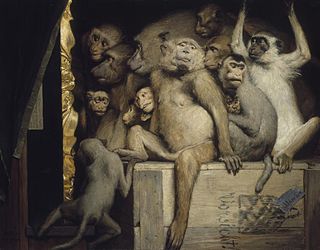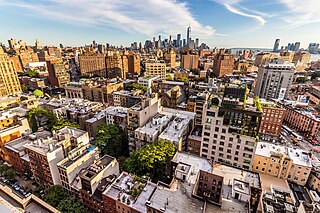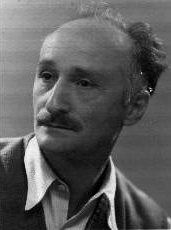Related Research Articles

Wolf Vostell was a German painter and sculptor, considered one of the early adopters of video art and installation art and pioneer of Happenings and Fluxus. Techniques such as blurring and Dé-coll/age are characteristic of his work, as is embedding objects in concrete and the use of television sets in his works. Wolf Vostell was married to the Spanish writer Mercedes Vostell and has two sons, David Vostell and Rafael Vostell.

Op art, short for optical art, is a style of visual art that uses optical illusions.

Art criticism is the discussion or evaluation of visual art. Art critics usually criticize art in the context of aesthetics or the theory of beauty. A goal of art criticism is the pursuit of a rational basis for art appreciation but it is questionable whether such criticism can transcend prevailing socio-political circumstances.
The term Soviet Nonconformist Art refers to Soviet art produced in the former Soviet Union from 1953 to 1986 outside of the rubric of Socialist Realism. Other terms used to refer to this phenomenon are counterculture, "underground art" or "unofficial art".

David Rosenberg is a French art curator and author, specialized in modern and contemporary art.

The 9th Street Art Exhibition of Paintings and Sculpture is the official title artist Franz Kline hand-lettered onto the poster he designed for the Ninth Street Show. Now considered historic, the artist-led exhibition marked the formal debut of Abstract Expressionism, and the first American art movement with international influence. The School of Paris, long the headquarters of the global art market, typically launched new movements, so there was both financial and cultural fall-out when all the excitement was suddenly emanating from New York. The post-war New York avant-garde, artists like Willem de Kooning and Jackson Pollock, would soon become "art stars," commanding large sums and international attention. The Ninth Street Show marked their "stepping-out," and that of nearly 75 other artists, including Harry Jackson, Helen Frankenthaler, Joan Mitchell, Grace Hartigan, Robert De Niro Sr., Philip Guston, Elaine de Kooning, Lee Krasner, Franz Kline, Ad Reinhardt, David Smith, Milton Resnick, Joop Sanders, Robert Motherwell, Barnett Newman and many others who were then mostly unknown to an art establishment that ignored experimental art without a ready market.

Ze’ev Raban (22 September 1890 – 19 January 1970), born Wolf Rawicki (Ravitzki), was a leading painter, decorative artist, and industrial designer of the Bezalel school style, and was one of the founders of the Israeli art world.
Boris Lurie was an American artist and writer. He co-founded the NO!Art movement which calls for socially and politically involved art that would resist and combat the forces of the market. His controversial work, often related to the Holocaust, has frequently irritated critics and curators.

Malva Schalek, aka Malvina Schalková, was a Czech-Jewish painter. Trained in Prague, she went on to work in Vienna as a painter. From 1942 to 1944 she was imprisoned in the Theresienstadt concentration camp. In 1944 she was moved to the Auschwitz concentration camp, where she died. Many of her works are held in the Ghetto Fighters' House in Israel.
Kommissar Hjuler works as a sound recordist in the field of Noise and Post-industrial music, visual artist, film maker and police officer at Flensburg, a town on the German border with Denmark. He often works together with his wife Mama Baer as Kommissar Hjuler und Frau. As self-taught artist he began making music in 1999 and visual art in 2006. He is considered to work in the field of neo dada, whereas his output also contains elements of fluxus, art brut.

Soviet art is a form of visual art produced after the October Socialist Revolution of 1917 in Soviet Russia (1917—1922) and the Soviet Union (1922—1991), when the short-lived Russian Republic was overthrown and replaced. This led to an artistic and cultural shift within Russia and the Soviet Union as a whole, including a new focus on Socialist Realism in officially approved art.
Mama Baer is a German sound recordist of noise music and post-industrial music. She is a filmmaker and visual artist at Flensburg. She has had solo and group art exhibitions around the world, and her short films have been presented at several film festivals.
Dietmar Kirves.

Aldo Tambellini was an Italian-American artist. He pioneered electronic intermedia, and was a painter, sculptor, and poet. He died at age 90, in November 2020.

Léonce Rosenberg was an art collector, writer, publisher, and one of the most influential French art dealers of the 20th century. His greatest impact was as a supporter and promoter of the cubists, especially during World War I and in the years immediately after.
Alan W. Moore is an art historian and activist whose work addresses cultural economies and groups and the politics of collectivity. After a stint as an art critic, Moore made video art and installation art from the mid-1970s on and performed in the 1979 Public Arts International/Free Speech series. He has published several books and runs the House Magic information project on self-organized, occupied autonomous social centers. His partial autobiography was published in 2022 in The Journal of Aesthetics & Protest as Art Worker: Doing Time in the New York Artworld. Moore lives in Madrid.

Alexander Bogen was a Polish-Israeli visual artist, a decorated leader of partisans during World War II, a key player in 20th century Yiddish culture, and one of the trailblazers for art education and Artists' associations in the emerging state of Israel.
Rocco Armento was an American sculptor, painter, and member of the NO!art movement. His postwar abstractions were influenced by Picasso, Giacometti, and Marini. He lived in Woodstock, NY in his self-built home with a geodesic dome studio.
Werner Rosenberg (1913-1988) known as Véro, was a German-born French photographer and photojournalist.

Esther Lurie was an Israeli painter.
References
- ↑ NO-Art: An American Psycho-Social Phenomenon Emanuel K. Schwartz and Reta Shacknove Schwartz, Leonardo, Vol. 4, No. 3 (Summer, 1971), pp. 245-254 MIT Press
- ↑ "Look--Ma ... No Sculpture", The Realist, November 1964
- ↑ Fletcher, Robert Beyond resistance: the future of freedom p.31
- ↑ Rosenberg, Harold “Bull by the Horns.” 1974 cited in First and Final Refusal—Resurrecting Boris Lurie, the Original NO!art Man Ezra Glinter, Forward, July 14, 2010
- ↑ NO!art Members, NO!art website. Accessed July 1, 2015.